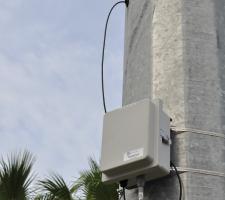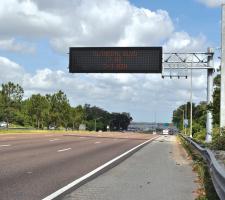
The Jacksonville skyline
David Crawford investigates innovative congestion management in Florida.
The whole array brings together 237 vehicle detectors (54 from
Some 100
The most visible expression of the CMS will be a new US$9 million, 2325m2 regional traffic management centre, which is due for completion by autumn 2014.
In addition to the traffic operations personnel, the new regional traffic management centre is designed to house the fire, rescue and emergency management staff as well as federal and local safety officers - to enable a more coordinated response to traffic incidents.
By the time the regional traffic management centre opens, instrumentation of Jacksonville’s main commuter arteries will be completed. Meanwhile, staff at the existing TMC are testing the dynamic control of stop lights in response to traffic data in what Florida Department of Transport (FDOT) District Two ITS engineer Peter Vega describes as a “critical learning process”.
Information from the sensors is already feeding into the statewide bilingual Florida 511 highway travel information service, accessed online at
Developed jointly with the San Antonio, Texas-based
SunGuide has been deployed in Jacksonville since 2005 and is now in use throughout the department’s eight districts and 15 TMCs (including those of toll agencies). Claimed benefits include lower risks, through the use of state and national standards (such as the US National Transportation Communications for ITS Protocol), uniform performance measures, lower software maintenance costs, and less time needed for software training.
In 2012, the TPO brought together the Southwest Research Institute and
The systems can, therefore, now talk to each other. TMC operators can pull up a map of the Jacksonville signals and use one of a predefined menu of timing plans which are based on the level of severity of an incident.
For example, if there is a major accident on the I-95 southbound, the operator will be able to alert motorists using variable message signs and the 511 system. Vehicles will be diverted onto the parallel Philips Highway, where the operator can, at the press a button, change the signal timing in accordance with the level of traffic that is detouring.
The operator can then use variable message signs on
Vega told ITS International: “I believe this integration is the first of its kind in the US. Historically, traffic signal control software has been proprietary and vendors have been hesitant to share information.
“What we did was take an HTML platform to provide just the signal information, and some control, to our roadway management software. Trafficware’s willingness to assist went beyond the norm for their industry.
“Other Florida District ITS offices are keeping themselves informed and have begun notifying their traffic signal control vendors of the possibility of similar deployments. They are basically taking a ‘wait and see’ approach until we have fully implemented our effort.”
In a further bid to aid diverted traffic, 17 small-scale variable message signs are going under test in autumn 2013 on streets that intersect the I-95. These will complement the large delay- or incident-alerting displays on the interstate itself, using arrow symbols or ‘turn left/right’ messages to help diverted drivers.
The CMS initiative includes a major element of future planning. Says Vega: “Even though congestion has not become as serious a problem as it is in other regions, there are areas with high levels of peak hour pressure and, as we continue to grow, so will these. For this deployment, we have selected areas with a high likelihood of explosive growth and ones which have been revitalised due to improvements in the economy.
“We have used knowledge gained from our signals staff and the traffic data provided by our third-party vendors. The system will also give the TPO year-round real-time data showing which corridors have slowed down, from road wear or nearby residential growth”.
At the same time, the North Florida Transportation Planning Organisation is looking at ways of improving flows and increasing capacity using solutions including express lanes (of the kind already being deployed in South Florida), hard shoulder running and ramp metering. In a bid to boost alternative commuting behaviour, it is also working with the Jacksonville Transportation Authority, a fellow partner in the 100-plus strong North Florida ITS Coalition of public- and private-sector organisations.
The main focus is on the development of bus corridors selected to determine the potential usefulness of transit signal priority (TSP). Deployment of the first – on a local section of the US Highway 1, which parallels the I-95 - is now complete with equipment procurement for a second, stretching 18km along Atlantic Boulevard, under way.
Jacksonville Transportation Authority also plans to introduce a bus rapid transit scheme over the next two years. Says Vega: “The Jacksonville is a key player in the decision-making process. We approach every project with the thought of ‘what can we do to deploy products that will be beneficial to transit?’”
Jacksonville achieved its present size in a 1968 consolidation of its own city government with that of the larger Duval County, of which it was the county seat, bringing a population of 836,500, the largest of any community in Florida, within the city limits.
Successive harbour improvements have made it a major military and civilian deep-water port, and it is an important tourist destination, particularly for golfers.














